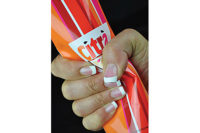Adhesives at Work: Stay Ahead of the Pack - Sticking to Food Packaging Regulations
Converters and brand owners must ensure that the adhesive selected is suitable for the application.


A raw materials supplier can provide valuable information that helps capture the “bigger picture” and helps businesses select the ideal materials for their food packaging products.




With increasing consumer demand for convenience comes greater demand for high performance standards and increased sustainability. The packaging industry is no stranger to these trends taking place with consumer products across the world. In fact, Smithers Pira released a market report in 2013 predicting that the flexible packaging industry will grow to $231 billion by 2018. While this is great news for flexible packaging, it presents a few challenges for the industry.
New materials and designs that help to meet consumer demand for more convenient, user-friendly food packaging—like complex multi-layer pouches, frozen food packaging ready to be reheated, and hot-fill packaging—are being introduced to the market and require unique adhesives that ensure product freshness, high performance and regulatory compliance. In response to packaging innovations, new testing capabilities and consumer demand for safe, high-quality products, ensuring compliance with governmental regulations from organizations like the U.S. Food & Drug Administration (FDA) and the U.S. Department of Agriculture (USDA) is more challenging for companies than ever before.
To remain competitive, the timing for moving a package design from prototyping to store shelves is much tighter; hence, packaging producers are seeking ways to control production costs while still remaining compliant to the regulations. There should be a priority on regulatory compliance, but this is not always the case.
Suitable Doesn’t Always Mean Safe
Many adhesives manufacturers claim their materials are suitable for food packaging applications; however, suitability may mean that the adhesive simply meets physical performance requirements for the package—not that it has been tested for the specific packaging application. Proceeding without careful consideration can result in contamination, leading to widespread negative media attention, lawsuits, lasting public censure, and permanent damage to brand reputations. As a result, millions of dollars could be incurred for added compliance costs, destroyed materials and lost sales while the final packaged product is off the shelves. In a white paper entitled “Supply Chain Risk Management,” Kinaxis Corp. found that 78% of food and beverage industry respondents are managing the risks of recalls through insurance, and many are particularly concerned about the impact of recalls on their brand’s reputation.
In order to avoid additional costs, fines and negative brand reputation, transparency has become a major trend and is being incorporated into every aspect of a product’s development—including packaging. With companies feeling pressure to take more ownership of the materials used in their products, they are collaborating more closely with every member of the value chain, including adhesives manufacturers, to enhance raw materials management. In turn, this is helping companies capture benefits that generate long-term value like cost reductions, enhanced brand reputation, increased customer and consumer trust, and expanding market share.
In “The Business Case for Knowing Chemicals in Products and Supply Chains,” author Mark Rossi notes how PricewaterhouseCoopers found that the financial impact on brand value from passive strategies, like poor supplier practices, can result in a decrease in market capitalization by 12%, whereas active strategies can provide a payback of up to 85 times program costs. To ensure FDA compliance for adhesives in food packaging applications, closer collaborations with trusted raw material suppliers are helping packaging producers understand claims related to product compliance while avoiding the additional financial impacts of noncompliance or internal testing.
While a converter or food packaging company may understand an end-use product’s needs, design, manufacturing conditions and filling requirements, a raw materials supplier can provide valuable information that helps capture the “bigger picture” and helps businesses select the ideal materials for their food packaging products. This also makes it easier to identify and resolve materials challenges during the design phase.
Converters’ Responsibilities
Some food packaging (e.g., retort, steam-sterilization, microwave, hot fill and seal, and wet food) require more demanding processing procedures that may mandate the need for extraction and migration testing. Adhesives in these applications play a key role in maintaining food freshness and preventing contamination.
State-of-the-art materials science, analytical, toxicology and risk assessment capabilities are vital in the adhesives evaluation process—from compositional compliance to extraction and migration testing. Some adhesives manufacturers have made the business investment and employ thorough testing protocols for adhesives supplied into food packaging applications. These manufacturers also tend to have a strong history of industry leadership on environmental health and safety performance.
It is imperative that converters and packaged goods companies ensure that the adhesive has the appropriate regulatory compliance for the intended use. Questions to ask adhesives suppliers to help in this validation include:
• What specific regulations and subsections address the materials we will be purchasing?
• Have you performed migration or extraction testing on these adhesives in the intended structures?
• Can you provide test data details, including film type and thickness, adhesive weights and component ratios, food stimulants, cure times, cure conditions, and temperatures?
• Are you aware of any restrictions we should consider, based on the test data details?
Although converters and brand owners are innovating across a range of application areas by using new packaging materials and commercializing advanced applications in much tighter timeframes and at reduced costs, it is important to give the right level of attention to regulatory compliance to avoid the consequences of food contamination. Just because an adhesive is deemed “suitable” by an adhesive manufacturer for a certain packaging applications does not necessarily indicate FDA compliance for that specific application. This is due to potential differences in test conditions at the adhesive manufacturer’s facility and the actual packaging conditions at the converter’s manufacturing plant.
It is the responsibility of the converters and the brand owners to ensure that the adhesive has a suitable status for the intended use. Converters and brand owners should hold adhesives manufacturers accountable to certify the basis of any FDA compliance claim backed by detailed data on compositional compliance, extraction testing and migration testing. A collective concentration on safety and compliance will result in competitive advantage and confidence throughout the value chain.
For more information, contact the author at bkrishnan1@dow.com or visit www.dow.com/packaging.
Looking for a reprint of this article?
From high-res PDFs to custom plaques, order your copy today!








